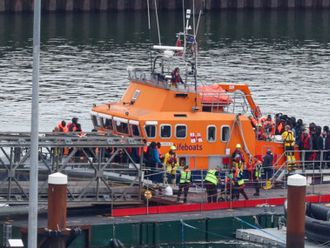
Bristol: In community halls, schools, churches, village centres — even in a launderette — 48 million Britons are eligible to vote in tomorrow’s general election.
Across the 650 constituencies, from the Outer Hebrides islands to the far south at John O’Groats at the foot of Cornwall, and from Antrim in Northern Island down to Thanet South those polling stations will be open from 7am to 10pm. And the future makeup of the United Kingdom’s parliament will be decided.
Yes, 48 million are eligible to vote, but turnout in general elections usually comes in anywhere between 60 and 70 per cent. And in most of those constituencies, the results are predictable to a high degree.
What is for sure is that a slew of opinion polls show little, if anything, between the two main parties.
The Conservatives under David Cameron and Labour under Ed Miliband — despite all of their huffing and puffing over these past weeks on the campaign trail — are virtually tied at support nationally at around 34 per cent each. But in Britain’s first-past-the-post system, when the candidate in each constituency with the most votes wins, the results weigh in favour of the two main parties.
To form a government, a majority of 326 seats is theoretically needed — but both Cameron and Miliband might fancy their chances of forming a minority administration — at risk of falling when contentious legislation is put to a confidence vote on the floor of the House of Commons.
There is also a slight wrinkle that changes the key 326 seat number and might tempt either Cameron or Miliband to go for it if a few seats short. Sinn Fein, the Irish Republican Party, usually wins two or three seats in Northern Ireland. Because the party is diametrically opposed to British rule over Northern Ireland, and because Members of Parliament must swear an oath of allegiance to Queen Elizabeth on taking their Commons seats, the elected Sinn Fein MPs have never taken their seats. The effect of that means that a majority of 324 might be enough.
And the Speaker of the House of Commons is constitutionally required to vote with the government in the event of a tie, by nominating and electing an MP from an opposing party as the Speaker in the new parliament, that 324 figure would become 323.
Most results will be coming in between three o’clock and five o’clock on Friday morning local time here — the UAE is three hours ahead now.
But there is also a key issue — while more than 30 million will vote, there are essentially 100,000 voters in 23 key constituencies that can swing either way — determining the final outcome of the tightest election campaign in 40 years.
Those 23 constituencies will be watched ever so closely for the slightest indication of swings — just enough to win an extra seat.
Those constituencies are in places like Plymouth Moor View, in the south west of England, where there is a three-way duel between Labour, the Conservatives and the United Kingdom Independence Party (Ukip)
In nearby Camborne and Redruth, just 66 votes in 2010 meant the Conservatives took the seat. Now with a Ukip candidate likely taking votes from the Conservatives, that 66 seat majority looks pretty thin. But it’s a seat the Conservatives will need to take if David Cameron is to have any realistic hope of forming the next government — with the help of a coalition partner.
What’s for sure is that when Britons wake up on Friday morning, the House of Commons will be like none other — it will be a rainbow parliament.
The Green Party are likely to win one seat — that of the party leader in Brighton.
The Democratic Ulster Unionists are expected to return nine MPs, while the other Northern Irish party, the Social Democratic Labour Party, may pick up a couple. Those MPs will be courted as never before.
With 55 out of 59 seats in Scotland likely to go to the Scottish Nationalist Party, that bloc — who are determined to take Scotland out of the United Kingdom, will have the ability to make of break Cameron or Miliband’s future careers.
And the Liberal-Democrats, who willing joined Cameron’s 303 seats to form a majority in 2010 are both weary and wary of being junior partners again. If the Lib-Dems can win 25 seats, they will consider the campaign to be a success.
With all of the permutations and combinations, those 100,000 voters that really matter — and the other 30 million or so as well — have a lot of thinking to do before they plant an ‘X’ in pencil beside a candidate’s name in the village halls, churches and schools and that launderette. Who knows what will come out in the wash?












